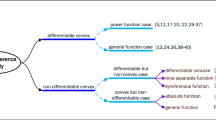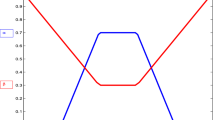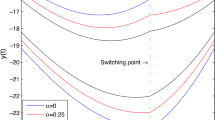Abstract
The object of this article is to determine Hyers-Ulam-Rassias stability results concerning the cubic functional equation in fuzzy normed space by using the fixed point method.
Similar content being viewed by others
1 Introduction, definitions and notations
Fuzzy set theory is a powerful hand set for modeling uncertainty and vagueness in various problems arising in the field of science and engineering. It has a large number of application, for instance, in the computer programming [1], engineering problems [2], statistical convergence [3–7], nonlinear operator [8], best approximation [9] etc. Particularly, fuzzy differential equation is a strong topic with large application areas, for example, in population models [10], civil engineering [11] and so on.
By modifying own studies on fuzzy topological vector spaces, Katsaras [12] first introduced the notion of fuzzy seminorm and norm on a vector space and later on Felbin [13] gave the concept of a fuzzy normed space (for short, FNS) by applying the notion fuzzy distance of Kaleva and Seikala [14] on vector spaces. Further, Xiao and Zhu [15] improved a bit the Felbin's definition of fuzzy norm of a linear operator between FNSs.
Stability problem of a functional equation was first posed by Ulam [16] which was answered by Hyers [17] under the assumption that the groups are Banach spaces. Rassias [18] and Gajda [19] considered the stability problem with unbounded Cauchy differences. The unified form of the results of Hyers, Rassias, and Gajda is as follows:
Let E and F be real normed spaces with F complete and let f : E → F be a mapping such that the following condition holds
for all x, y ∈ E, θ ≥ 0 and for some p ∈ [0, ∞) | {1}. Then there exists a unique additive function C : E → F such that
for all x ∈ E.
This stability phenomenon is called generalized Hyers-Ulam stability and has been extensively investigated for different functional equations. It is to be noted that almost all proofs used the idea imaginated by Hyers. Namely, the additive function C : E → F is explicitly constructed, starting from the given function f, by the formulae (i) , if p < 1; and (ii) , if p > 1. This method is called a direct method. It is often used to construct a solution of a given functional equation and is seen to be a powerful tool for studying the stability of many functional equations. Since then several stability problems and its fuzzy version for various functional equations have been investigated in [20–26]. Recently, Radu [27] proposed that fixed point alternative method is very useful for obtaining the solution of Ulam problem.
The stability problem for the cubic functional equation was proved by Jun and Kim [21] for mappings f : X → Y, where X is a real normed space and Y is a Banach space. In this article, we show that the existence of the limit C(x) and the estimation (i) and (ii) can be simply obtained from the alternative of fixed point.
In this section, we recall some notations and basic definitions used in this article.
A fuzzy subset N of X × ℝ is called a fuzzy norm on X if the following conditions are satisfied for all x, y ∈ X and c ∈ ℝ;
-
(a)
N(x, t) = 0 for all non-positive t ∈ ℝ,
-
(b)
N(x, t) = 1 for all t ∈ ℝ+ if and only if x = 0,
-
(c)
for all t ∈ ℝ+ and c ≠ 0,
-
(d)
N(x + y, t + s)≥ min{N(x, t), N(y, s)} for all s, t ∈ ℝ,
-
(e)
N(x, t) is a non-decreasing function on ℝ, and supt∈ℝ N(x, t) = 1.
The pair (X, N) will be referred to as a fuzzy normed space.
Example 1.1. Let (X, ||.||) be a normed linear space. Then
is a fuzzy norm on X.
Example 1.2. Let (X, ||.||) be a normed linear space. Then
is a fuzzy norm on X.
Let (X, N) be a fuzzy normed space. Then, a sequence x = (x k ) is said to be fuzzy convergent to L ∈ X if lim N(x k - L, t) = 1, for all t > 0. In this case, we write N-lim x k = L.
Let (X, N) be an fuzzy normed space. Then, x = (x k ) is said to be fuzzy Cauchy sequence if lim N(x k+p - x k , t) = 1 for all t > 0 and p = 1, 2, ....
It is known that every convergent sequence in a fuzzy normed space (X, N) is Cauchy. Fuzzy normed space (X, N) is said to be complete if every fuzzy Cauchy sequence is fuzzy convergent. In this case, (X, N) is called fuzzy Banach space.
2 Fixed point technique for Hyers-Ulam stability
In this section, we deal with the stability problem via fixed point method in fuzzy norm space. Before proceeding further, we should recall the following results related to the concept of fixed point.
Theorem 2.1 (Banach's Contraction principle). Let (X, d) be a complete generalized metric space and consider a mapping J : X → X be a strictly contractive mapping, that is
for some (Lipschitz constant) L < 1. Then
-
(i)
The mapping J has one and only one fixed point x* = J(x*);
-
(ii)
The fixed point x* is globally attractive, that is
for any starting point x ∈ X;
-
(iii)
One has the following estimation inequalities for all x ∈ X and n ≥ 0:
(2.1.1)(2.1.2)(2.1.3)
Theorem 2.2 (The alternative of fixed point) [28]. Suppose we are given a complete generalized metric space (X, d) and a strictly contractive mapping J : X → X, with Lipschitz constant L. Then, for each given element x ∈ X, either
or
for some natural number n0. Moreover, if the second alternative holds then
-
(i)
The sequence (Jnx) is convergent to a fixed point y* of J;
-
(ii)
y* is the unique fixed point of J in the set
-
(iii)
.
We are now ready to obtain our main results.
The functional equation
is called the cubic functional equation, since the function f(x) = cx3 is its solution. Every solution of the cubic functional equation is said to be a cubic mapping.
Let φ be a function from X × X to Z. A mapping f : X → Y is said to be φ-approximately cubic function if
for all x, y ∈ X and t > 0.
Using the fixed point alternative, we can prove the stability of Hyers-Ulam-Rassias type theorem in FNS. First, we prove the following lemma which will be used in our main result.
Lemma 2.1. Let (Z, N') be a fuzzy normed space and φ : X → Z be a function. Let E = {g : X → Y; g(0) = 0} and define
for all h ∈ E. Then d M is a complete generalized metric on E.
Proof. Let g, h, k ∈ E, d M (g, h) < ξ1 and d M (h, k) < ξ2. Then
for all x ∈ X and t > 0. Thus
for each x ∈ X and t > 0. By definition d M (h, k) < ξ1 + ξ2. This proves the triangle inequality for d M . Rest of the proof can be done on the same lines as in (see [[29], Lemma 2.1]).
Theorem 2.3. Let X be a linear space and (Z, N') be a FNS. Suppose that a function φ : X × X → Z satisfying φ(2x, 2y) = αφ(x, y) for all x, y ∈ X and α ≠ 0. Suppose that (Y, N) be a fuzzy Banach space and f : X → Y be a φ-approximately cubic function. If for some 0 < α < 8
and
for all x, y ∈ X and t > 0. Then there exists a unique cubic mapping C : X → Y such that
for all x ∈ X and all t > 0.
Proof. Put y = 0 in (2.0.2). Then for all x ∈ X and t > 0
Consider the set E = {g : X → Y, g(0) = 0} together with the mapping d M defined on E × E by
It is known that d M (g, h) complete generalized metric space by Lemma 2.1. Now, we define the linear mapping J : E → E such that
It is easy to see that J is a strictly contractive self-mapping of E with the Lipschitz constant . Indeed, let g, h ∈ E be given such that d M (g, h) = ε. Then
for all x ∈ X and t > 0. Thus
It follows from (2.3.1) that
for all x ∈ X and t > 0. Therefore
This means that
for all g, h ∈ E. Next, from
we have
Using the fixed point alternative we deduce the existence of a fixed point of J, that is, the existence of a mapping C : X → Y such that C(2x) = 8C(x), for all x ∈ X. Moreover, we have d M (Jnf, C) → 0, which implies
for every x ∈ X. Also
This implies that
Replacing t by 2(8 - α)t in the above equation, we obtain
for all x ∈ X and t > 0.
Let x, y ∈ X. Then
Replacing x and y by 2nx and 2ny, respectively, we obtain
for all x, y ∈ X and all t > 0. Since
we conclude that C fulfills (2.0.1).
The uniqueness of C follows from the fact that C is the unique fixed point of J with the following property that there exists u ∈(0, ∞) such that
for all x ∈ X and t > 0.
This completes the proof of the theorem.
By a modification in the proof of Theorem 2.3, one can prove the following:
Theorem 2.4. Let X be a linear space and (Z, N') be a FNS. Suppose that a function φ : X × X → Z satisfying
for all x, y ∈ X and α ≠ 0. Suppose that (Y, N) be a fuzzy Banach space and f : X ← Y be a φ-approximately cubic function. If for some α > 8
and
for all x, y ∈ X and t > 0. Then there exists a unique cubic mapping C : X → Y such that
for all x ∈ X and all t > 0.
The proof of the above theorem is similar to the proof of Theorem 2.3, hence omitted.
3 Conclusion
This study indeed presents a relationship between three various disciplines: the theory of fuzzy normed spaces, the theory of stability of functional equations and the fixed point theory. This method is easier than those of previously proved (stability problem) by other authors for fuzzy setting. We established Hyers-Ulam-Rassias stability of a cubic functional equation in fuzzy normed spaces by using fixed point alternative theorem.
Author' information
Address of both the authors: Department of Mathematics, Faculty of Science, King Abdu-laziz University, P.O. Box 80203, Jeddah 21589, Saudi Arabia. Email: mohiuddine@gmail.com (S.A. Mohiuddine); mathker11@hotmail.com (A. Alotaibi).
References
Giles R: A computer program for fuzzy reasoning. Fuzzy Sets Syst 1980, 4: 221–234.
Hanss M: Applied fuzzy arithmetic: an introduction with engineering applications. Springer-Verlag, Berlin; 2005.
Mohiuddine SA, Danish Lohani QM: On generalized statistical convergence in intuitionistic fuzzy normed space. Chaos Solitons Fract 2009, 42: 1731–1737.
Mursaleen M, Mohiuddine SA: Statistical convergence of double sequences in intuitionistic fuzzy normed spaces. Chaos Solitons Fract 2009, 41: 2414–2421.
Mursaleen M, Mohiuddine SA: On lacunary statistical convergence with respect to the intuitionistic fuzzy normed space. J Comput Appl Math 2009, 233(2):142–149.
Mursaleen M, Mohiuddine SA, Edely OHH: On the ideal convergence of double sequences in intuitionistic fuzzy normed spaces. Comput Math Appl 2010, 59: 603–611.
Mohiuddine SA, Şevli H, Cancan M: Statistical convergence in fuzzy 2-normed space. J Computational Analy Appl 2010, 12(4):787–798.
Mursaleen M, Mohiuddine SA: Nonlinear operators between intuitionistic fuzzy normed spaces and Fr'echet differentiation. Chaos Solitons Fract 2009, 42: 1010–1015.
Mohiuddine SA: Some new results on approximation in fuzzy 2-normed spaces. Math Comput Model 2011, 53: 574–580.
Guo M, Li R: Impulsive functional differential inclusions and fuzzy population models. Fuzzy Sets Syst 2003, 138: 601–615.
Oberguggenberger M, Pittschmann S: Differential equations with fuzzy parameters. Math Mod Syst 1999, 5: 181–202.
Katsaras AK: Fuzzy topological vector spaces. Fuzzy Sets Syst 1984, 12: 143–154.
Felbin C: Finite dimensional fuzzy normed linear spaces. Fuzzy Sets Syst 1992, 48: 239–248.
Kaleva O, Seikala S: On fuzzy metric spaces. Fuzzy Sets Syst 1984, 12: 215–229.
Xiao JZ, Zhu XH: Fuzzy normed spaces of operators and its completeness. Fuzzy Sets Syst 2003, 133(3):135–146.
Ulam SM: A Collection of the Mathematical Problems. In Interscience Publ. New York; 1960.
Hyers DH: On the stability of the linear functional equation. Proc Natl Acad Sci USA 1941, 27: 222–224.
Rassias TM: On the stability of the linear mapping in Banach spaces. Proc Am Math Soc 1978, 72: 297–300.
Gajda Z: On stability of additive mappings. Int J Math Math Sci 1991, 14: 431–434.
Alotaibi A, Mohiuddine SA: On the stability of a cubic functional equation in random 2-normed spaces. Adv Diff Equ 2012, 2012: 39.
Jun KW, Kim HM: The generalized Hyers-Ulam-Rassias stability of a cubic functional equation. J Math Anal Appl 2002, 274: 867–878.
Jung SM, Kim TS: A fixed point approach to the stability of the cubic functional equation. Bol Soc Mat Mexicana 2006, 12(1):51–57.
Mohiuddine SA: Stability of Jensen functional equation in intuitionistic fuzzy normed space. Chaos Solitons Fract 2009, 42: 2989–2996.
Mohiuddine SA, Şevli H: Stability of Pexiderized quadratic functional equation in intuitionistic fuzzy normed space. J Comput Appl Math 2011, 235: 2137–2146.
Mursaleen M, Mohiuddine SA: On stability of a cubic functional equation in intuition-istic fuzzy normed spaces. Chaos Solitons Fract 2009, 42: 2997–3005.
Mirmostafaee AK: A fixed point approach to almost quartic mappings in quasi fuzzy normed spaces. Fuzzy Sets Syst 2009, 160: 1653–1662.
Radu V: The fixed point alternative and the stability of functional equations. Sem Fixed Point Theory 2003, 4(1):91–96.
Diaz JB, Margolis B: A fixed point theorem of the alternative for contractions on generalized complete metric space. Bull Am Math Soc 1968, 126(74):305–309.
Miheţ D, Radu V: On the stability of the additive Cauchy functional equation in random normed spaces. J Math Anal Appl 2008, 343: 567–572.
Acknowledgements
The authors would like to thank the anonymous reviewers for their valuable comments.
Author information
Authors and Affiliations
Corresponding author
Additional information
Competing interests
The authors declare that they have no competing interests.
Authors' contributions
Both the authors contributed equally and significantly in writing this paper. All authors read and approved the final manuscript.
Rights and permissions
Open Access This article is distributed under the terms of the Creative Commons Attribution 2.0 International License (https://creativecommons.org/licenses/by/2.0), which permits unrestricted use, distribution, and reproduction in any medium, provided the original work is properly cited.
About this article
Cite this article
Mohiuddine, S.A., Alotaibi, A. Fuzzy stability of a cubic functional equation via fixed point technique. Adv Differ Equ 2012, 48 (2012). https://doi.org/10.1186/1687-1847-2012-48
Received:
Accepted:
Published:
DOI: https://doi.org/10.1186/1687-1847-2012-48




